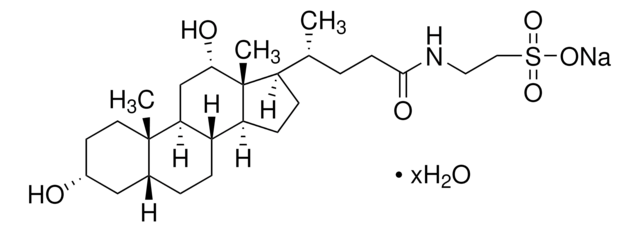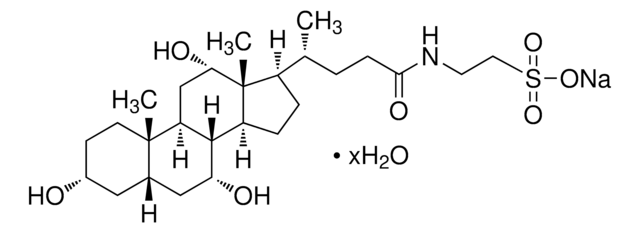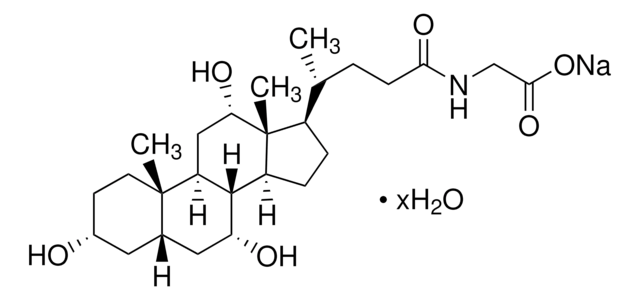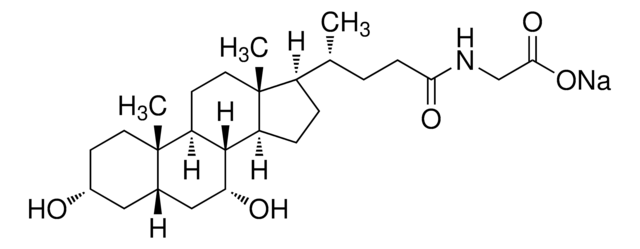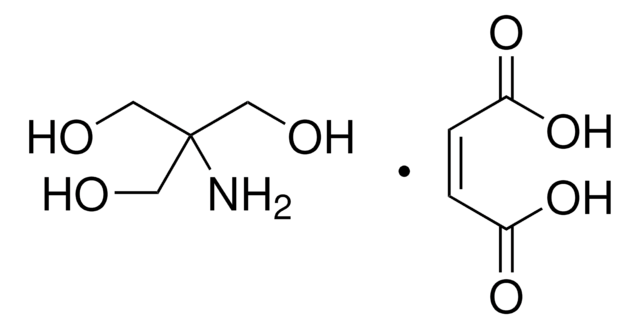T0557
Sodium taurodeoxycholate hydrate
BioXtra, ≥97% (TLC)
Synonym(s):
2-([3α,12α-Dihydroxy-24-oxo-5β-cholan-24-yl]amino)ethanesulfonic acid, Taurodeoxycholic acid sodium salt hydrate
About This Item
Recommended Products
description
anionic
product line
BioXtra
assay
≥97% (TLC)
mol wt
micellar avg mol wt 3100
aggregation number
6
impurities
≤0.002% Phosphorus (P)
≤0.1% Insoluble matter
CMC
1-4 mM (20-25°C)
solubility
H2O: 0.5 M, clear, colorless to faintly yellow
anion traces
chloride (Cl-): ≤0.5%
sulfate (SO42-): ≤0.05%
cation traces
Al: ≤0.0005%
Ca: ≤0.005%
Cu: ≤0.0005%
Fe: ≤0.0005%
K: ≤0.01%
Mg: ≤0.005%
NH4+: ≤0.05%
Pb: ≤0.001%
Zn: ≤0.0005%
SMILES string
O.[Na+].C[C@H](CCC(=O)NCCS([O-])(=O)=O)[C@H]1CC[C@H]2[C@@H]3CC[C@@H]4C[C@H](O)CC[C@]4(C)[C@H]3C[C@H](O)[C@]12C
InChI
1S/C26H45NO6S.Na.H2O/c1-16(4-9-24(30)27-12-13-34(31,32)33)20-7-8-21-19-6-5-17-14-18(28)10-11-25(17,2)22(19)15-23(29)26(20,21)3;;/h16-23,28-29H,4-15H2,1-3H3,(H,27,30)(H,31,32,33);;1H2/q;+1;/p-1/t16-,17-,18-,19+,20-,21+,22+,23+,25+,26-;;/m1../s1
InChI key
OLPIZAYYAVQETM-GGPRKOIFSA-M
Looking for similar products? Visit Product Comparison Guide
General description
Application
Storage Class
11 - Combustible Solids
wgk_germany
WGK 3
flash_point_f
Not applicable
flash_point_c
Not applicable
ppe
Eyeshields, Gloves, type N95 (US)
Choose from one of the most recent versions:
Already Own This Product?
Find documentation for the products that you have recently purchased in the Document Library.
Customers Also Viewed
Articles
The liver excretes excess cholesterol in the form of bile acids. Bile acids serve two purposes: to remove unwanted cholesterol from the body and to aid in lipid digestion in the intestine.
Today, diverse studies report the benefits of probiotics, such as inhibitory effects on pathogens, aid in the management or prevention of chronic intestinal inflammatory diseases or atopic syndromes, and support to the immune system. Potential beneficial applications abound, researchers continue to evaluate the effictiveness and clarify the mechanisms of action of probiotics.
Our team of scientists has experience in all areas of research including Life Science, Material Science, Chemical Synthesis, Chromatography, Analytical and many others.
Contact Technical Service